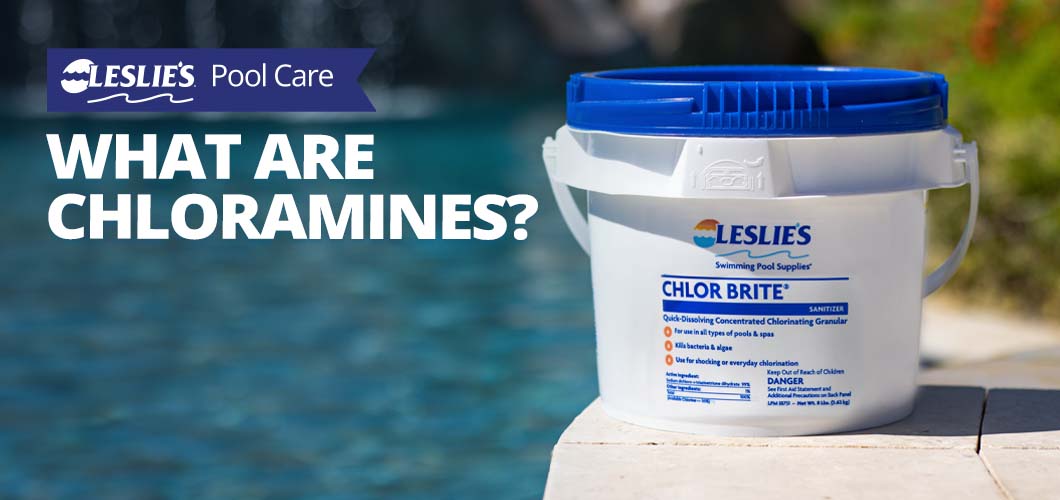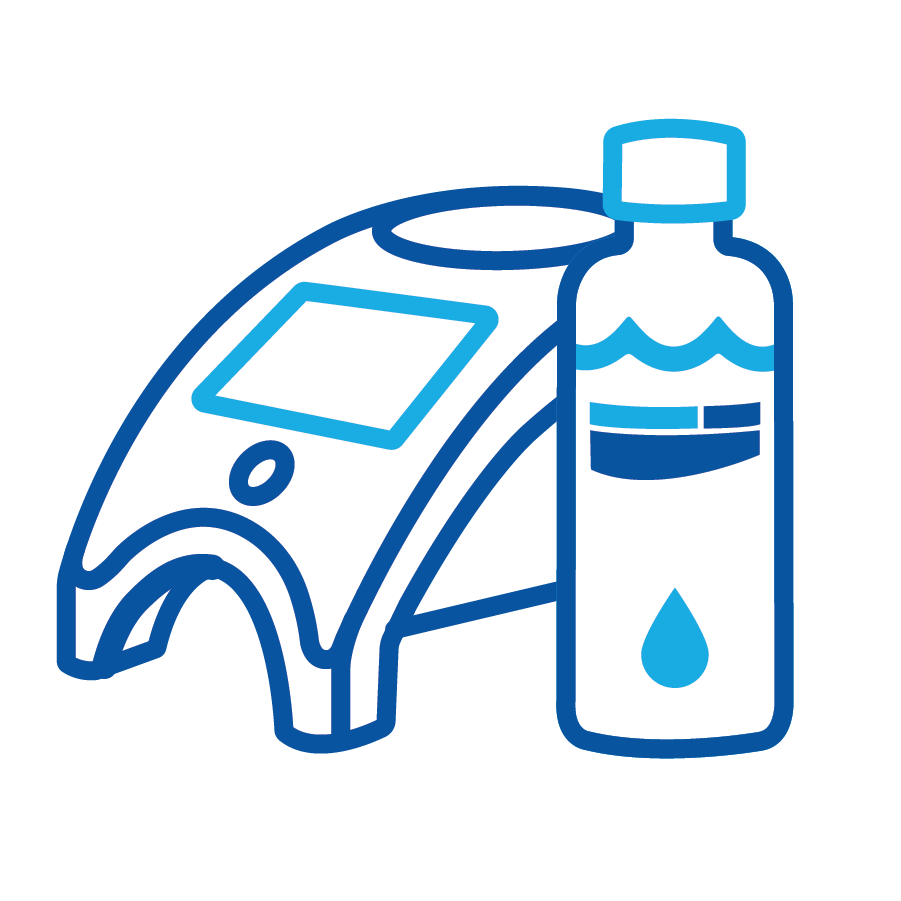
What Are Chloramines?
Proper pool sanitization is crucial for maintaining a safe and enjoyable swimming environment. When a pool isn't properly sanitized, it becomes a breeding ground for harmful pathogens, such as bacteria, which can pose significant health risks to swimmers. A well-sanitized pool prevents waterborne illnesses and keeps the water clear and inviting. However, as chlorine works to break down organic matter like sweat and body oils in your pool, it bonds with certain chemical compounds to form chloramines, also known as Combined Chlorine. Not only are chloramines a less effective sanitizer, they also cause irritation to the skin, eyes, and respiratory system. This highlights the need for regular and effective pool maintenance to ensure both the safety and comfort of swimmers.
Chloramines Explained
Chloramines form when Free Chlorine, the working chlorine in your pool, interacts with nitrogen and ammonia compounds. These nitrogen and ammonia compounds come from various contaminants, including sweat, oils, and cosmetics introduced into the pool by swimmers. When these substances mix with Free Chlorine, they create chloramines.
Why Are Chloramines a Problem?
Chloramines are problematic for several reasons:
- Reduced Sanitizing Effectiveness: Chloramines are significantly less effective at sanitizing your pool compared to Free Chlorine. Free Chlorine works efficiently to destroy algae, bacteria, and other disease-causing microbes, but chloramines have 60 to 80 times less sanitizing power. This decrease in effectiveness can leave your pool vulnerable to bacteria and other contaminants.
- Unpleasant Odors: You might have noticed a strong chlorine-like smell around pools, especially public ones. Contrary to popular belief, this odor isn’t caused by the chlorine itself, but by chloramines. When chloramines are present, they emit a distinct smell often mistaken for high chlorine levels. Not only is the odor unpleasant, it can also lead to airway irritation.
- Eye and Skin Irritation: High levels of chloramines can cause discomfort for swimmers, including red, itchy eyes, and skin irritation. This irritation is often mistaken for an allergic reaction to chlorine, but it's actually the result of chloramines.
Preventing and Removing Chloramines
Managing chloramines in your pool is crucial for maintaining a clean, safe, and pleasant swimming environment. Here are some strategies to prevent and eliminate this issue:

Shock regularly

Maintain chlorine levels

Ensure sufficient circulation
Shock the Pool Regularly:
Shocking your pool involves adding a large dose of chlorine or a non-chlorine oxidizer to the water to break down chloramines and other organic contaminants. Shock at least once a week to maintain a Free Chlorine level between 1 and 4 parts per million (ppm). This will also help keep the chloramine level in check. Here are some helpful tips for shocking your pool effectively:
Shock After Heavy Usage or Storms:
It’s essential to shock your pool weekly, plus additional treatments after hosting a pool party, bouts of stormy weather, or other events that bring a lot of debris and contaminants into your pool. The influx of contamination increases the formation of chloramines and may cause the Free Chlorine level to drop.
Choose the Right Shock:
If your Free Chlorine level is below 2 parts per million (ppm), use a chlorinated shock — such as Power Powder Plus or Chlor Brite — to superchlorinate the water, destroy chloramines, and bring the Free Chlorine level up. When the Free Chlorine level is at or above 2 ppm, you can opt for a chlorine-free oxidizer like Fresh 'N Clear to address chloramines and non-living organic contaminants in the water.
Maintain Proper Chlorine Levels:
Keeping your pool’s Free Chlorine level within the recommended range of 1–4 ppm helps ensure there's enough chlorine available to effectively sanitize the water and keep chloramines in check.
Test the Water Regularly:
Frequently testing your pool water helps you monitor chlorine levels and identify the presence of chloramines. Testing is also useful for tracking other important aspects of water chemistry. Check the Free Chlorine level and Total Chlorine level weekly. The difference between the two is your Combined Chlorine level, or how much chloramine is in the water. We recommend using a reliable water testing kit or bringing a water sample to your nearest Leslie’s location for professional testing. At Leslie's, we offer FREE in-store water testing to precisely measure 10 different aspects of water chemistry.
Maintain Sufficient Pool Circulation and Filtration:
Ensure your pool’s circulation and filtration systems are working well. Good circulation distributes chlorine evenly throughout the pool, while the filter helps remove organic matter that can react with chlorine to form chloramines.
Understanding the Different Types of Chloramines
Chloramines exist in different forms, and understanding them can help you manage your pool more effectively:
- Monochloramine: This is the first stage of chloramine formation. While monochloramine is less effective than Free Chlorine, it is relatively stable and doesn’t produce as much irritation as other chloramines.
- Dichloramine: When monochloramine reacts further with chlorine, or as the ratio of chlorine to ammonia increases, it forms dichloramine. This type is more irritating and contributes to a noticeable chlorine odor.
- Trichloramine (Nitrogen Trichloride): This is the final stage and is the most problematic. Trichloramine is responsible for the strong chlorine smell and is highly irritating to the eyes and airways. It’s commonly found in poorly ventilated indoor pools and is most challenging to get rid of.
The Role of Pool Maintenance in Managing Chloramines

Regular pool maintenance is key to managing chloramines. Here are additional tips to keep your pool in top shape:
- Skim, Brush, and Vacuum: Algae and debris can contribute to chloramine formation. Regularly brush, skim, and vacuum the pool to help keep your pool clean and reduce organic matter that reacts with chlorine.
- Clean Your Filter: Cleaning or backwashing your pool’s filter removes trapped debris and contaminants, which can contribute to chloramine production.
- Monitor pH Levels: Maintaining a balanced pH level (usually between 7.2 and 7.8) ensures that chlorine remains effective at sanitizing the water. Imbalanced pH can reduce chlorine’s efficiency and contribute to chloramine formation.
Understanding and managing chloramines is crucial for a healthy and enjoyable pool environment. By recognizing the signs of chloramine presence and taking proactive steps to prevent and eliminate them, you can ensure your pool remains clean, safe, and inviting. For more information on how to care for your pool, check out our Resource Center, visit our YouTube channel, or stop by your local Leslie’s and speak with one of our experts!